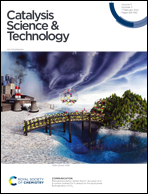Computational and experimental investigation of Co and S-doped Ni2P as an efficient electrocatalyst for acid mediated proton exchange membrane hydrogen evolution reaction†‡
Abstract
Engineering earth-abundant and high performance electrocatalysts to facilitate the hydrogen evolution reaction (HER) for generation of sustainable hydrogen fuel has been a major scientific and technological challenge in the electrolytic water splitting area. Herein, employing theoretical first principles calculations of HER thermodynamics and kinetics-based density functional theory (DFT), we report a platinum group metal (PGM)-free Co and S containing Ni2P [(Ni0.95Co0.05)2P:x at% S (x = 5, 10, 15)] system as highly active and robust electrocatalysts for acidic HER. On the basis of the DFT calculations, the (Ni0.95Co0.05)2P:15S composition reveals optimal hydrogen adsorption free energies (ΔGH*) and beneficial modification of the surface electronic structure. Accordingly, the (Ni0.95Co0.05)2P:15S electrocatalyst, synthesized via a simple and facile low temperature solid state approach, demonstrates significantly higher HER performance in comparison to pristine Ni2P and comparable HER performance to the state-of-the-art Pt/C electrocatalyst. Owing to the unique modification of the electronic structure i.e. change in the density of states (DOS) and optimized ΔGH*, the (Ni0.95Co0.05)2P:15S composition exhibits a considerably lower charge transfer resistance (6.82 Ω cm2), lower overpotential (44 mV at 10 mA cm−2), smaller Tafel slope (31.25 mV dec−1), smaller water contact angle (7°) and correspondingly, a smaller bubble break-off diameter (0.38 mm) with a higher mass activity (43.75 A g−1 at −0.05 V) in comparison to (Ni0.95Co0.05)2P:x at% S (x = 0, 5, 10) and Ni2P. The highly active composition, (Ni0.95Co0.05)2P:15S also displays a long term electrochemical HER stability, similar to Pt/C, with no major degradation in its electrochemical activity, reflective of its excellent structural robustness for acidic HER. Consequently, the present experimental study fortified by theory provides novel synergistic insights into designing promising and efficient multi-component HER electrocatalysts.



 Please wait while we load your content...
Please wait while we load your content...
